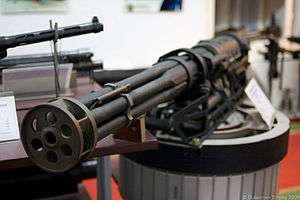Gryazev-Shipunov GSh-6-23
| Gryazev-Shipunov GSh-6-23 | |
|---|---|
 | |
| Type | Rotary cannon |
| Place of origin | Soviet Union |
| Production history | |
| Designer | Vassily P. Gryazev and Arkady G. Shipunov |
| Manufacturer | KBP Instrument Design Bureau Tula |
| Specifications | |
| Weight | 73–76 kg (161–167 lb) |
| Length | 1.4 m (4 ft 7 in) |
| Height | 18 cm (7 in) |
|
| |
| Cartridge | 23×115mm AM-23 |
| Barrels | 6, Rifled |
| Action | Gas-operated |
| Rate of fire | 9,000-10,000 rpm.[1] |
| Muzzle velocity | 715 m/s (2345 ft/s) |
| Feed system | Belt or linkless feed system |
The Gryazev-Shipunov GSh-6-23 (Russian: Грязев-Шипунов ГШ-6-23) (GRAU designation: 9A-620 for GSh-6-23, 9A-768 for GSh-6-23M modernized variant) is a six-barreled 23 mm rotary cannon used by some modern Soviet/Russian military aircraft.
The GSh-6-23 differs from most American multi-barreled aircraft cannon in that it is gas-operated, rather than externally powered via an electric, hydraulic, or pneumatic system. Although the engineering difficulties involved in producing a gas-operated rotary cannon with such a high rate of fire are considerable, they create less of a drain on the aircraft's power systems and are more reliable in combat, since they can continue to fire even in the event of a power system failure.
The GSh-6-23 uses the 23x115 Russian AM-23 round, fed via linked cartridge belt or a linkless feed system.[2] The linkless system, adopted after problems with the belt feed, is limited to 8,500 rpm.[3] Fire control is electrical, using a 27 V DC system. The cannon has 10 pyrotechnic cocking charges, similar to those used in European gas-operated revolver cannons such as the DEFA 554 or Mauser BK-27.
The rapid rate of fire exhausts ammunition quickly: the Mikoyan MiG-31 aircraft, for example, with 260 rounds of ammunition (800 rounds maximum), would empty its magazine in less than two seconds.
The GSh-6-23 is used by the Sukhoi Su-24 attack aircraft, the MiG-31 interceptor aircraft, and the now-obsolete Sukhoi Su-15 among others. However, after two Su-24s were lost because of premature shell detonation in 1983, and because of some other problems with gun usage (such as system failures), usage of the GSh-6-23 was stopped by a decision of the Soviet Air Force Command. At present all aircraft in the Russian Air Force are flying with fully operational guns, but without ammunition.[4]
It is also used in the SPPU-6 gun pod, which can traverse to -45° elevation, and +-45° azimuth.
See also
References
- ↑ "No body does it better: Russian Aircraft Cannons Outgun America's - Sputnik international".
- ↑ "From 20mm to 25mm - The Russian Ammunition Page". Retrieved 26 November 2014.
- ↑ "Untitled Document". Retrieved 26 November 2014.
- ↑ "Untitled Document". Retrieved 26 November 2014.
Sources
- Rapid Fire, Anthony G. Williams, Airlife UK, August 2000
- Koll, Christian (2009). Soviet Cannon - A Comprehensive Study of Soviet Arms and Ammunition in Calibres 12.7mm to 57mm. Austria: Koll. p. 162. ISBN 978-3-200-01445-9.
External links
- KPB Tula (designer/manufacturer)
- Izhmash (Archive copy of manufacturer's page, in Russian)
- Gsh-6-23M (9-A-768) (automatic translation of the above)
- (Animated gif of operation)